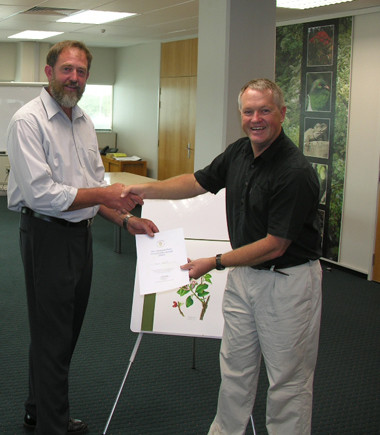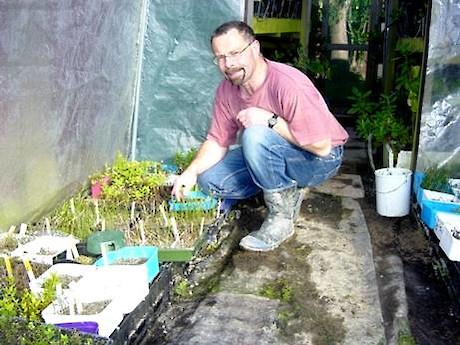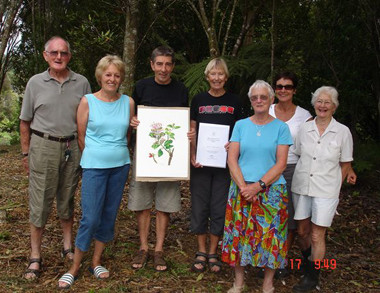New Zealand’s leading guardians of the country’s native plants have been recognised with awards from the New Zealand Plant Conservation Network. The award winners include two primary schools, community-based nurseries and a South Island district council, with a special achievement award for a native plant enthusiast from West Auckland.
 Individual Award
Individual Award
Winner: Wayne Bennett
Wayne Bennett (left) receives the Network’s individual award for his efforts to lift the profile of ecological restoration planting and eco-sourcing in the Waikato. The judges said the award acknowledged a vast accumulation of knowledge on native plant propagation, fruiting and flowering phenology and restoration planting. Mr Bennett recently established an eco-sourcing plant nursery and shares his knowledge widely. He produces a newsletter profiling plants and ecosystems and runs propagation and seed collection workshops as part of Eco-Sourced Waikato. He has also been heavily involved in projects to save threatened flora such as Cook’s scurvy grass.
 Community Award
Community Award
Winner: Royal Forest and Bird Protection Society’s Home Nursery
The Royal Forest and Bird Protection Society’s Home Nursery in Wellington receives the award for best community project. The Wellington Home Nursery Group has provided endemic plants for land restoration in and around Wellington for the past 15 years. It was established through concern with the local council’s inaction on plant diversification. Around 150,000 plants have been raised from eco-sourced seeds, including many species that are under threat nationally. Of these, around 50,000 plants have been supplied to the city council and 100,000 to restoration groups and projects. Garry James (left is one of the main coordinators of the Home Nursery Scheme)
Council Award
Winner: Marlborough District Council
The Marlborough District Council received the Network’s council award for its Significant Natural Area (SNA) programme. Coastal and lowland southern Marlborough has little remaining indigenous habitat and a high proportion of threatened ecosystems. Marlborough’s SNA project has extended across privately owned land throughout southern Marlborough and the Marlborough Sounds. The Network’s judges commented that it is a model for achieving conservation gains in partnership with land owners. Over 250 Marlborough property owners have welcomed input from ecologists to carry out plant and habit surveys, with more than 680 hectares identified as ecologically significant.
 Nursery Award
Nursery Award
Winner: Kerikeri Shadehouse
Kerikeri Shadehouse, a community-based nursery providing plants for restoration projects, has won the Network’s nursery award. It has provided inexpensive plants for restoration and revegetation projects in the Bay of Islands (especially Motupapa Island, Motukawanui and Waewaetorea Island) and on the mainland (including Bream Head, Te Paki, and Mimiwhangata). Over the past eight years the nursery has provided more than 50,000 eco-sourced plants and received an award from the Department of Conservation’s Northland Conservancy. The judges said the nursery’s ability to provide high quality plants at low cost is a major achievement in plant conservation.
School Award
Winners: Paroa School and Maruia School
This year two schools received awards. Paroa School, on the South Island’s West Coast, received an award for a little blue penguin project that began in 2005. The project has broadened to look at the protection of the whole beach environment and now grows pingao / pikao (Desmoschoenus spiralis) in tunnel houses for planting along the dunes. The knowledge gained from the project has been integrated into the school curriculum.
Maruia School, in Buller in the South Island, received an award for its work with two threatened plants: Melicytus flexuosus and Coprosma wallii. These threatened plants feature in pupils’ learning both inside and outside the classroom, with pupils helping Department of Conservation staff with planting into hare exclosures in the Maruia Valley. The school has also established its own nursery on the school grounds and officially adopted a planting site early in 2007 where it displays the school’s art and interpretive information about the plants.
Lifetime Achievement
Winner: Geoff Davidson
Geoff Davidson of Oratia Valley, West Auckland, received the Life Time Achievement Award from the Network’s National Council. This award recognised Mr Davidson’s work to save species from extinction, running the country’s top nursery (Oratia) and being part of major initiatives to protect plants and plant communities. These include the Kaikoura Island Trust and the Native Forest Restoration Trust. The judges commented that Mr Davidson has been a consistent ambassador for New Zealand plant life and has always been first to offer assistance with research on indigenous plants.
